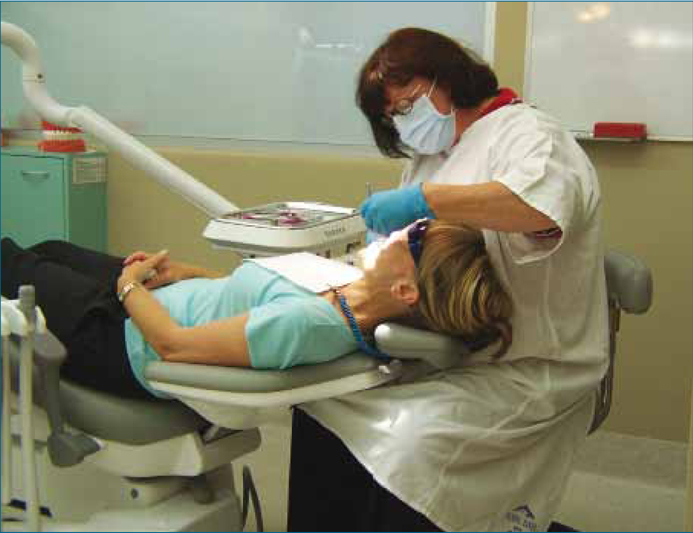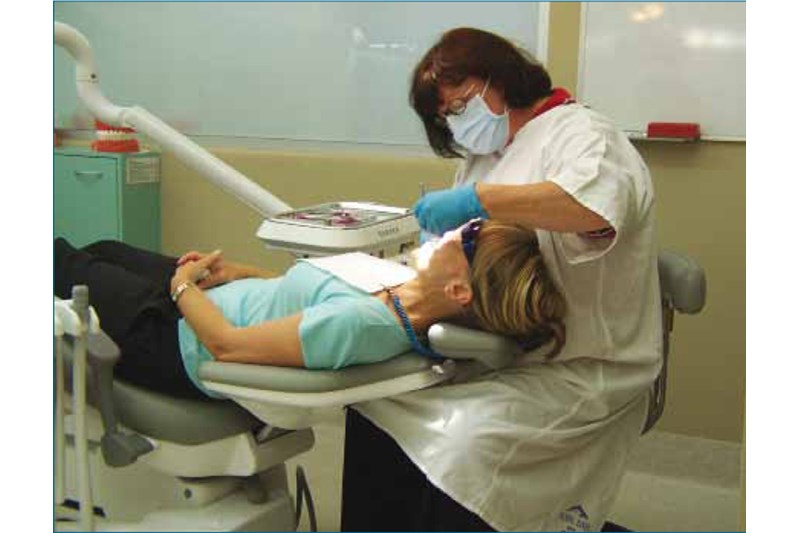Musculoskeletal disorders related to dentistry work
Published: 01/04/2013
Dental care professionals often experience work-related musculoskeletal disorders, usually linked to awkward posture and repetitive movements over a long period of time. Practitioners need to be aware of the risks and the steps they can take to minimise the likelihood of these injuries
Work-related musculo-skeletal disorders (WMSDs) are a significant occupational health issue in dentistry (Leggat et al. 2007; Puriene et al. 2007; Hayes et al. 2009a). WMSDs are defined as injuries to the human support system, which consists of the bones, muscles, ligaments and tendons, as well as the vascular and nerve supply (Luttman et al, 2007). Commonly affected body regions include the neck, shoulder and lower back, but they can affect any area of the body, including elbows, wrists, hips, knees and ankles (Graham, 2002).
WMSDs can occur after a single event but, in the field of dentistry, occur more commonly after cumulative trauma, as a result of repetitive movements and constant low-weight bearing on the muscles (Luttman et al, 2007).
These occupational injuries are a concern for dental personnel, as they contribute significantly to sick leave, reduced working hours or productivity, and even leaving the profession (Crawford et al. 2005; Leggat et al. 2007).
Many different WMSDs affect dental personnel. The most common injuries include tendonitis, bursitis and carpal tunnel syndrome. Tendonitis and bursitis are both inflammatory conditions, with the former affecting the attachment between the muscle and the bone and the latter affecting the sacs of synovial fluid surrounding the joints (National Institute of Arthritis and Musculoskeletal and Skin Diseases (2011). Carpal tunnel syndrome is a painful disorder caused by pressure on the median nerve of the wrist (Lalumandier et al. 2001a). Common signs and symptoms of WMSD are included in Box 1 (Lalumandier et al. 2000; Graham, 2002).
id="bx1" position="float" orientation="portrait">Box 1.
Signs and symptoms of WMSD
Pain
Numbness
Tingling
Coldness
Clumsiness
Weakness
Swelling
Impaired range of motion
Decreased muscle strength
Prevalence of WMSD
High prevalence rates among dentists and dental hygienists have been widely reported. In a recent systematic review, the evaluation of numerous studies found that WMSDs among dentists were most prevalent in the back (36.3%–60.1%) and the neck (19%–85%), while dental hygienists experienced more wrist/hand pain (60%–69.5%) (Hayes et al. 2009a).
However, studies examining WMSD among dental nurses and assistants are scarce. A study of US army dental personnel found that dental assistants experienced WMSDs at similar rates to dentists (Lalumandier et al. 2001b), while a study comparing Canadian dental hygienists and assistants found that the hygienists experienced more wrist/ hand, shoulder and neck pain, while the assistants reported more lower back pain (Liss et al, 1995).
Regardless of these comparisons, the proportion of the whole dental workforce— including dentists, dental hygienists and dental nurses—experiencing WMSD is sizeable. In addition, the evidence suggests that WMSD signs and symptoms may begin as early as during dental education and training (Hayes, 2009b; Morse et al, 2003). These findings are concerning for career satisfaction and longevity in dentistry.
Risk factors for WMSD
Common risk factors for WMSD among all dental personnel are associated with working posture and repetitive movements. Working posture is considered a significant risk factor for WMSD, considering the restricted field of vision associated with working in the oral cavity, continued low-level muscle loading causing fatigue, long periods spent bent in a sitting position accompanied by bending and twisting, and forward head posture. Examples of poor working postures are shown in Figures 1 and 2.

Figure 1.Poor working posture: arms raised and forward head posture

Figure 2.Poor working posture: torso twisted and neck bent
Repetitive movements are another key risk factor, and these can be associated with scaling, drilling and filling teeth. The use of vibrating tools such as handpieces and ultrasonic scalers also increases the risk of WMSD, as do awkward hand and wrist postures adopted while using instruments or suctioning.
Dentists and dental nurses/assistants have a greater variety of daily work tasks than dental hygienists, who are constantly exposed to the same repetitious tasks—namely scaling— for extended periods. However, dental nurses and assistants are restricted in their ability to control their working position, as this depends on the clinician’s position, allowing them less room to manoeuvre.
What is not clear is which of the aforementioned tasks pose a greater risk than others, and it is uncertain whether there is a safe amount of time that can be spent on risky tasks..
Factors not related to clinical work can play a role, namely psychological issues and gender. A study of Swedish female dental workers, including dentists, hygienists and nurses, found that those reporting WMSD had higher scores for work-related concerns and lower scores for support and influence in the workplace (Lindfors et al. 2006). Similarly, Australian dental hygienists who felt work interfered in their home life were more likely to report neck and wrist/hand WMSD, and those who were rarely involved in practice decisions reported more shoulder and upper back WMSD (Hayes et al. 2012).
Female gender appears to be positively correlated with the severity of WMSD (Marshall et al, 1997; Alexandre et al, 2011) which is concerning for hygienists and nurses in particular, as these occupations are predominantly female.
Ergonomic principles
Neutral positioning is an important concept in the prevention of WMSD. This concept is about maintaining the natural curves of the spine, as correct joint alignment and muscle balance is believed to maintain a healthy musculoskeletal system (Sunell and Rucker, 2004).
Neutral positioning can be complemented by an ergonomically designed chair, correct operator and patient positioning, and proper use of the mirror and light (Sunell and Rucker, 2004). Operator and assistant chairs should have an adjustable height, with the operator chair having an adjustable back rest and the assistant’s chair a moveable belly bar. Where possible, the chair should be adjusted so that the thighs are almost parallel to the ground, and dental workers should sit with their knees apart and feet flat on the floor for stability (Lalumandier et al. 2001b; Valachi and Valachi, 2003).
Sitting as close as possible to the patient will help limit excessive bending from the back or neck, although sometimes this can be difficult for assistants, as they need to work around the operator.
Maintaining core strength is essential while seated, and all workers should make a conscious effort to pivot forward from the hips rather than bend from the waist (Valachi and Valachi, 2003). Brackets and adjustable work benches should be positioned within easy reach, to avoid unnecessary reaching, bending and twisting.
Improving visibility of the oral cavity can help dental personnel maintain a neutral position. Angling the light correctly and using the mirror for indirect vision, indirect illumination and during retraction of soft tissues will assist with this (Lalumandier, 2001b).
Strategies for prevention
While many strategies have been proposed for preventing WMSD, little research has evaluated how effective they are (Hayes, 2010). It has been suggested that the use of loupes and certain types of instruments support neutral positioning and therefore prevent WMSD.
The use of instruments that are wider in diameter and lighter in weight is recommended, as these have been shown to require less pinch force and muscle load (Dong et al, 2006). A recent research study (Hayes, unpublished observations) has investigated the effect of loupes on WMSD; while the hygienists involved in the study reported improved symptoms after wearing loupes, there were only minimal changes in range of motion and muscle strength.
Dental workers should consider themselves an ‘occupational athlete’, so warming up at the start of the work day is essential. Activities that prepare the neuromuscular and articular systems for the day ahead include aerobic exercise, muscle strengthening or simple stretching manoeuvres (Lalumandier et al. 2001b; Valachi and Valachi, 2003).
Stretching should also be performed at intervals during the work day, as this addresses the negative effects of static, awkward postures by increasing the blood flow to muscles, increasing the production of synovial joint fluid, maintaining the normal range of motion, creating a relaxation response and identifying ‘tight’ muscles that may be predisposed to injury (da Costa and Vieria, 2008).
Changes in the workplace routine can also help to minimise stress and WMSD. Ensure that enough time is scheduled for each patient, rest breaks are scheduled, and alternate between procedures or rotate between tasks (Lalumandier et al. 2001b).
It is important to seek medical attention promptly if you are aware of any potential problem areas. Health practitioners such as physiotherapists, osteopaths, medical doctors and chiropractors may be able to provide advice on how to manage your problem, and may also be able to alleviate symptoms or treat the injury.
sec-type="conclusions">Conclusion
WMSD are a significant occupational health problem for all dental personnel. Increased awareness of the magnitude of the problem and risk factors should motivate dentists, hygienists and assistants to employ ergonomic principles and strategies to limit potential injuries.
position="float" orientation="portrait">? Work-related musculoskeletal disorders (WMSDs) are common in dental care professionals and can start as early as during training.
? Risk factors for WMSDs in dental staff are associated with repetitive movements and awkward posture.
? Repetitive movements are associated with scaling, drilling and filling teeth. other risk factors are vibrating tools and awkward hand and wrist postures.
? Psychological issues and gender can also play a role.
? While many strategies, including positioning and using different instrument types, have been proposed for preventing WMSDs, little research has evaluated their effectiveness.
? Neutral positioning to help prevent WMSDs can be supported by an ergonomically designed chair, correct operator and patient positioning, and proper use of the mirror and light.
KEY POINTS
Author: MA Healthcare
Please sign in or subscribe to continue reading.
The following article is restricted for Dental Nursing subscribers only. Please sign in to access the full article.
If you have any queries or require more information, Dental Nursing’s friendly customer services team is on hand to help. Call 01722 716997 or email subscriptions@markallengroup.com.
Subscribe to Dental Nursing below and get access to this article. Subscribing will enable you to:
- Update your knowledge in important areas of practice.
- Keep fully up-to-date with the latest developments taking place in clinical practice as they affect you.
- Access restricted content and our CPD platform.








.jpg?width=150&height=100&scale=canvas)




